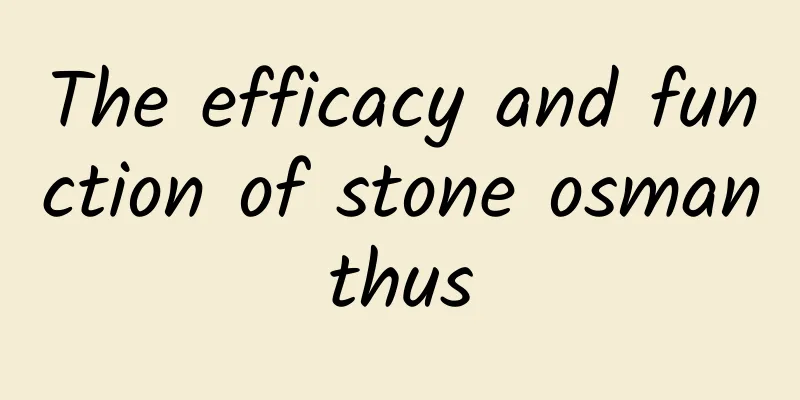The efficacy and function of stone osmanthus

|
Speaking of stonecrop, many people know that it is a traditional Chinese medicinal material. So do you know the effects and functions of stonecrop? How should it be eaten? Let’s find out now. [Alias] Shisu (Kaibao Materia Medica), mosquito grass (Guangxi Wild Resource Plants), stone wormwood, walking alone for a thousand miles (Luchuan Materia Medica), green Elsholtzia (Chinese Materia Medica Records), five-spice grass (Hangzhou Medicinal Plant Records), fine-leaved Elsholtzia (Hunan Medicinal Records), small Elsholtzia (Guizhou Plant Medicinal Survey), Guangxi Elsholtzia, small-leaved Elsholtzia (Discussion on Chinese Medicinal Material Varieties), wild Elsholtzia, fine-leaved Seven-Star Sword (Guangzhou Army's Commonly Used Chinese Herbal Medicine Handbook), Elsholtzia, sha medicinal herb, Artemisia capillaris, earthenware, wild perilla, shepherd's purse, wild shepherd's purse (Zhejiang Folk Commonly Used Herbs), ten-spice grass (Guangxi Chinese Herbal Medicines), shepherd's purse (Jiangxi Herbal Medicines). [Source] It is the whole herb of Elsholtzia ciliata, a plant of the Lamiaceae family. The above-ground parts are harvested in summer, the roots are removed and sun-dried. [Original form] Lithospermum officinale (Compendium of Materia Medica), also known as: Huaqizhu. [Habitat distribution] Grown in wasteland, roadsides, field edges, and grass on hillsides. Distributed in Jiangsu, Zhejiang, Fujian, Guangdong, Guangxi, Hunan, Hubei, Sichuan, Guizhou and other places. It is mainly produced in Hunan and Hubei. In addition, it is also produced in Guangxi and other places. [Properties] The whole plant is dried and covered with hair, about 20 to 30 cm long. The stem is thin, square-cylindrical in the upper part, slightly wavy and branched; the base is purple-red, the upper part is gray-green, the nodes are obvious, and the internodes are about 3 cm long; the texture is brittle, easy to break, and the cross section is fibrous. The leaves are opposite, lanceolate, gray-green to green, wrinkled, easily broken, and mostly without inflorescence. It has a fragrant aroma and tastes spicy, cool and slightly burning. The best seedlings are those that are short, green, have many leaves and tender branches. [Chemical composition] Contains about 0.7% volatile oil, 65% carvacrol, 6% carvacrol acetate, as well as p-cymene, α-thujacene, linalool, borneol, α-caryophyllene, etc. [Pharmacological action] Volatile oil, stable in nature, with aromatic smell. It has been proven in vitro that it has a strong antibacterial effect against Staphylococcus aureus, β-streptococcus, meningococcus, catarrhalis, Bacillus subtilis, Bacillus anthracis, Corynebacterium diphtheria, Proteus, Pseudomonas aeruginosa, Escherichia coli, Salmonella typhi, and Shigella flexneri. It not only has antibacterial effect, but also has bactericidal effect; its bactericidal power is much greater than that of carbolic acid and volatile oil of Eucalyptus globulus; serum has no obvious effect on its effect. Elsholtzia oil has a strong antibacterial effect against type A meningococci in test tubes. A 0.1% volatile oil suspension sprayed into the throat can control influenza within 3 days. In vitro tests (chicken embryo inoculation) show that it has a certain inactivation ability against influenza viruses, with the inactivation concentration ranging from 1:1000 to 1:2000; the inactivation concentration of its water extract is between 1:200 and 1:400. Subcutaneous injection of 50 mg of Elsholtzia oil in young rabbits may cause certain toxic reactions. 【Nature and flavor】Acrimonious, warm. 【Functions and indications】Relieve heat, promote blood circulation, regulate qi, and eliminate dampness. It is used to treat summer colds, nausea and vomiting due to heatstroke, abdominal pain and diarrhea, bruises and pains, eczema, and furunculosis. [Usage and Dosage] For oral use: decoct in water, 2 to 4 qian; or grind into powder. For external use: decoct, wash, mash or grind into powder for application. [Additional prescription] ① To prevent and treat colds; 2 qian each of shepherd's purse, mint, and tangerine peel, 4 qian of honeysuckle stems and leaves, and 3 green onions, boil them in water and drink as tea. 【Clinical application】 ①Prevention of influenza 【Excerpt】 《*Dictionary》 The utilization rate of stonecrop in traditional Chinese medicine is still very high, and it can be used to treat a variety of diseases. We should eat it after fully understanding its effects and functions. I hope everyone doesn’t eat carelessly. |
<<: The efficacy and function of Shixiantao
>>: The efficacy and function of gum wood
Recommend
Why can’t we stay in the last room of the hotel?
One minute with the doctor, the postures are cons...
Contraindications of Strychnos nux vomica
Strychnos nux vomica is a Chinese herbal medicine...
Ministry of Commerce: 2024 Silver E-commerce Development Report
At the end of 2023, the population aged 60 and ab...
The efficacy and function of alligator meat
Alligator meat is a very familiar medicinal mater...
Anatomy atlas hidden in Chinese characters
"These Chinese characters unearthed from the...
The efficacy and function of edelweiss
There are many kinds of common Chinese medicinal ...
World Dance Day | Beware! This "dangerous move" can cause disability, but many people actually think it is good for children.
Today is World Dance Day . In recent years, dance...
Common knowledge about the effects of Chinese herbal medicine
Moneywort is a type of traditional Chinese medici...
The efficacy and function of walnut flowers
Walnut flower is a medicinal material and is quit...
The efficacy of traditional Chinese medicine nine layers of skin
The Chinese medicinal herb Jiujiepi comes from th...
The efficacy and function of ghost hair needle
For Chinese medicinal materials such as ghost hai...
Taurine eye drops
We all should know that we cannot do without our ...
The efficacy and function of golden waist arrow
The environment is now seriously deteriorating an...
The "purple" in front of you is not purple? What kind of purple are you talking about?
Recently, Zhang Chaoyang mentioned a statement in...
The efficacy and function of Tiaojingcao
For the Chinese medicinal material such as Tiaoji...









